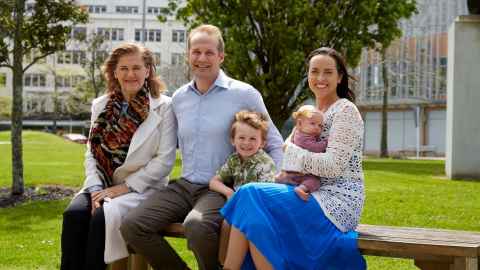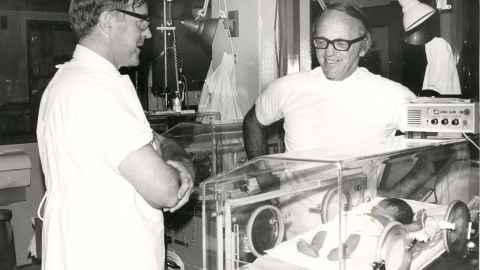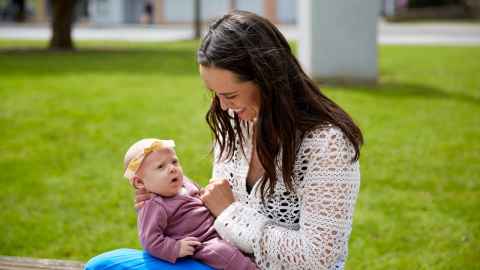Baby Isla benefits from 60-year Liggins family link
8 October 2024
Holocaust survivor Lewis Bieder donated medications for critical Kiwi research more than 50 years ago. He had no idea it would help millions of babies worldwide – including a member of his family three generations on.

When Olivia Rothwell’s waters broke at just 33 weeks of pregnancy, she was called into hospital for antibiotics and a dose of antenatal corticosteroids to help prevent breathing problems in her baby.
Isla was born just 12 hours later, before the recommended second dose could be given, but she could breathe perfectly on her own and was able to have skin-to-skin contact with her mum straightaway.
Baby Isla, like millions of babies before her all over the world, had benefitted from the 1972 discovery by New Zealand obstetrician and medical researcher Sir Graham ‘Mont’ Liggins that steroids given to mums at risk of preterm birth could speed up lung maturation and reduce breathing difficulties in their babies.
What made Isla different was that her great grandfather had played a key role in supporting Liggins' ground-breaking research.
Supplying the drugs for Mont Liggins' research
Lewis Bieder was Austrian and a practising doctor when, in 1938, he was forced to flee the horrors of Nazi-occupied Vienna and found himself in New Zealand. He married a fourth-generation Kiwi and made his home in Palmerston North, up the road from where, in 1904, businessman Joseph Nathan had set up a baby formula factory, using excess milk from local farms.
Nathan's business morphed into pharmaceutical company Glaxo Laboratories (and eventually became multinational drug giant GlaxoSmithKline). In the late 1960s, at the time when Mont Liggins was beginning his research into preterm labour, Lewis Bieder was its New Zealand medical director.
Liggins contacted Bieder looking for the steroid medication he needed for his pregnancy trials. Realising the importance of the research, Lewis arranged with his bosses at Glaxo to supply the project with betamethasone for free.
Miracle medicine: How antenatal steroids revolutionised neonatal care
A free public lecture organised by the Liggins Institute
Tuesday 22 October 2024, 6:00pm - 7:00pm
Find out more and reserve your tickets for a fascinating evening. Drinks and nibbles provided afterwards
In December 1969 Mont Liggins and paediatrician Ross Howie began the clinical trial that, by its end in 1977, would involve more than 1,000 women.
The participants were women expected to give birth at 24–36 weeks’ gestation. Each was given either betamethasone or a placebo, and unless delivery had already taken place, they also received a second injection of the same substance 24 hours later.

The initial results were compelling: the betamethasone-treated group had a far smaller number of deaths than the control group. We now know it’s because steroids speed up the development of a baby’s lungs, gut, cardiovascular and immune systems, which do not fully mature until after 36 weeks’ gestation.
Today the administration of antenatal corticosteroids is a routine treatment worldwide for pregnant women at risk of giving birth before 35 weeks and tens if not hundreds of thousands of babies have survived thanks to this Kiwi discovery.
Mont Liggins the obstetrician
When Lewis Bieder’s daughter Jill Rothwell became pregnant, Bieder asked for Mont Liggins to be her obstetrician. “He was a lovely obstetrician,” Rothwell recalls, “and he was obviously very fond of dad because every time he came in he’d ask ‘How’s Lewis’ and I’d pass on messages between them”.
Rothwell's first baby, Sam, was small for gestational age and mum and baby were in National Women’s for six weeks. “In those days, small for dates babies were treated with bed rest and it was terrible! I wasn’t allowed home, it was very strict.” Liggins also delivered Rothwell's second baby, Barnaby, now father to Isla.
Rothwell has fond memories of Mont Liggins and recalls him being very cool and calm. “He had a forestry block in Northland and he used to come in and his hands were black – ingrained with dirt from digging and planting trees," she says.
Paving the way for clinical trial participation
The day after baby Isla was born, in 2020, the team from the Liggins Institute DIAMOND Study (Different Approaches to Moderate and late preterm Nutrition: Determinants of feed tolerance, body composition and development) team paid Olivia Rothwell a visit to ask if she and Isla would like to be involved in a new clinical trial. The study was looking at different ways of providing nutritional support to preterm babies learning how to breastfeed. Olivia agreed to take part, and the link to Liggins clicked.
Her mother-in-law Jill Rothwell had recently published a book entitled Against All Odds, about Lewis Bieder (Jill's father)'s escape from Nazi Germany to New Zealand and his life in his new country. Olivia had read the book and now made the connection between her husband's grandfather and the steroid treatment she had just received.
It was amazing timing having just read Jill’s book about Isla’s great grandfather and then receiving Mont’s treatment, and then joining a Liggins Institute study
Babies grow very fast in the last trimester of pregnancy, doubling their weight and tripling their brain development. In utero they receive all their nutrition from their mother, but we know very little about the nutrition they need if they’re born early, and how this can affect their brain growth and development.
The DIAMOND Study was trying to find out whether the type of nutrition and the way it is provided can influence this, as well as investigating whether babies who get to smell and taste milk before a nasogastric tube feed learn to breastfeed quicker.
“We didn’t need to think much about whether or not to take part in the study, knowing that Liggins was attached to it. It seemed like a fairly easy thing to do that would be a big help and have massive implications for others,” says Isla’s father, Barnaby, a University of Auckland alumnus.
So, baby Isla got to smell and taste her food before her tube feeds. She also had an MRI scan shortly after she was born and another one when she was equivalent to full-term. And she had developmental follow-ups until she was two and a half to see how she tracked against others of a similar age. Compared to the experience of most new mums, “there’s not much you’re doing that would be different,” says Olivia.
Support every step of the way

Olivia and Barnaby have noticed a greater level of support from being involved in a clinical trial, with regular visits and updates from the study team.
“The MRI was an extra level of information that was scary to hear about at first as Isla had a small brain haemorrhage, but the doctor reassured us that this is perfectly normal in preterm babies,” says Olivia. “I was a bit anxious that day, but the study team made sure all the specialists were available to talk about it if needed.”
Although it was a little overwhelming to be asked to participate in a trial just after having a preterm baby, Olivia and Barnaby are happy to be part of research that is trying to improve outcomes for babies.
“It’s a bit full on right at the start being asked about being in a trial, but there’s absolutely no harm happening to your child, it’s just a different range of options being given,” says Olivia.
The steroids that helped Isla were trialled for a long time so if we can in a small way help future parents with preterm babies grow into strong, healthy kids then it’s pretty amazing to be a part of that.
A previous version of this story was published in November 2020 as 'Joining the dots through four generations'.
Media contact
Nikki Mandow | Research communications
M: 021 174 3142
E: nikki.mandow@auckland.ac.nz